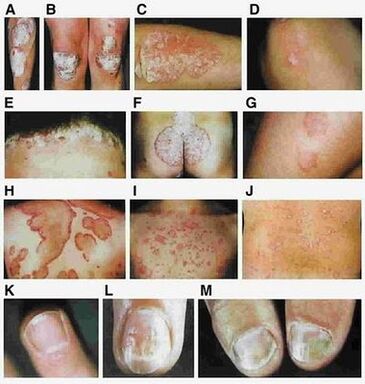The characteristic species-specific signs of psoriasis play a decisive role in diagnosis and treatment.
- Do not allow the disease to spread to a large area of skin;
- Quickly eliminate the external symptoms of the disease and prevent damage to internal organs;
- Take timely measures to prevent recurrence and extend the calm period of the disease.
The terms "symptoms" and "signs", although similar in meaning, have significant differences. Symptoms are a person's subjective feelings that can be confirmed or refuted by examining data. Physical signs are objective examination and examination data used by doctors to make a diagnosis.
For example, pain is purely a symptom, whereas a rash is a sign.
general sign
- On the hands, palms, or elbow areas;
- below the knee;
- in the inguinal fold;
- On both sides of lower back;
- on the tibia;
- On the scalp beneath the hair.
The first rash on the skin is usually barely noticeable, does not form in clusters, and does not cause any discomfort. But if at this stage a specialist is not consulted and the onset of the disease is ignored, the nails on the hands and feet will gradually begin to be damaged, and then the disease will spread to the mucous membranes and then to the joints.
- A round rash of varying sizes, dark pink or red in color, with many white scales visible. Gradually, although each patient has their own way, the rash area gradually thickens and becomes significantly higher than the surface of the skin. The rash forms psoriatic plaques that resemble drippings from a paraffin candle.
- Small, dense papules form in clusters on the elbows, palms, and sometimes along the knees and ankles. These signs are so insignificant that people simply do not notice them and confuse them with ordinary stimuli. It's important to listen to yourself to see if you're experiencing the characteristic symptoms of psoriasis, such as itching and pain to touch. If you miss the first symptoms of psoriasis, individual pimples can quickly turn into plaques that can be difficult to remove.
- "Stearic acid dyeing effect". The small transparent scales peel off easily when the surface of the plaque is scratched.
- "Terminal Film Effect". If the exfoliated scales are removed, they are replaced by a thin, shiny surface of skin that is brightly colored.
- "blood effect". At the scraped site, tiny droplets of blood will appear within a short period of time.
Classification

- non-pustular form, characterized by distribution across the entire skin surface, including the following types:
- Simple (vulgar) or ordinary psoriasis, characterized by a stable chronic course with the development of plaques. The vulgar type is the most common, accounting for 85% of cases.
- Psoriasis erythroderma. A dangerous type, which always occurs in severe form, affects the skin's thermoregulatory and barrier abilities. Often, erythrodermic psoriasis leads to pyoderma or sepsis.
- pustular formIt is characterized not by the formation of papules, but by the formation of pustules - inflamed skin blisters filled with serum fluid. In their course, these forms of the disease can be systemic (distributed over the entire skin surface) or localized, occurring mainly in the areas of the palms and soles of the feet.
- Systemic psoriasis Tsumbusha type;
- Type of annular erythema;
- Barber's palmoplantar type (chronic pustulosis of the extremities);
- annular pustular psoriasis;
- Persistent acrodermatitis (psoriasis of the soles and palms of the feet);
- Psoriasis impetigo herpetiformis.
- seborrheic;
- exudative;
- forms of drug dependence;
- Inverse psoriasis on the surface of skin folds and folds.
Characteristic symptoms of different types of psoriasis
- flexion of arms and legs;
- the border between the forehead and scalp;
- Back of hand.
Teardrop type
Atypical appearance
- skin folds,
- side of body
- armpit.
Pustular (oozing) appearance
wrinkled surface psoriasis
- Bend your arms and joints below your knees;
- axillary and inguinal folds;
- external genitalia;
- The area of skin beneath a woman's breasts.























